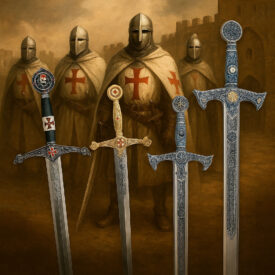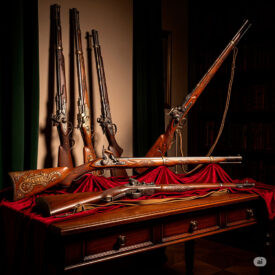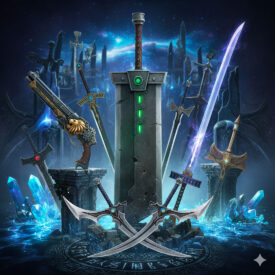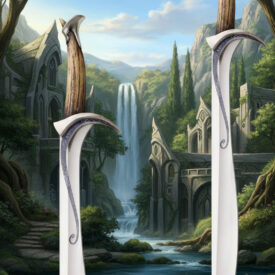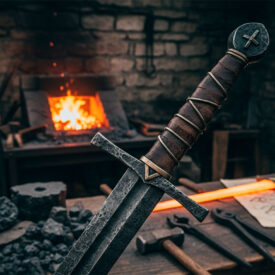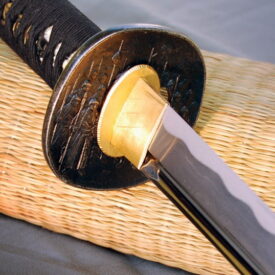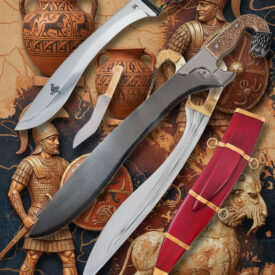Imagine the clash of steel under the scorching sun of the Iberian Peninsula, the echo of legendary battles, and the indomitable spirit of heroes forging history with the tip of a blade. Spain, a land of conquerors and an unparalleled military legacy, has been the cradle of some of the most emblematic swords coveted by collectors worldwide. More than simple weapons, these pieces are testaments to artisanal skill, symbols of power, and artifacts that whisper stories of old. Are you ready to immerse yourself in the fascinating universe of historical Spanish swords and discover why these five steel jewels are invaluable treasures for any expert?
From the curved blades that challenged Rome to the elegant rapiers that accompanied the hidalgos of the Golden Age, each sword we will present below is a living chapter of Spanish identity. Join us on this journey through forging, combat, and legend, unveiling the unwavering appeal of these magnificent works of art and war.
From the falcata to the 1910 model: evolution and milestones of Spanish swords
| Era | Event |
|---|---|
| Iron Age / Pre-Roman era (9th to 1st century BC) | |
| Falcata | Iberian curved weapon with a wide blade, typical of pre-Roman peoples of the peninsula; used in warfare and emblematic of the Iberian warrior. |
| Short sword / Dagger of Alar del Rey | Weapon with a short hilt and a pronounced central ridge, characteristic of pre-Roman Iberian tradition. |
| Roman Republic and Empire (3rd century BC – 3rd century AD) | |
| Gladius ibericus | Type of Iberian sword adopted and valued by the Romans as a thrusting and cutting weapon in their legions. |
| High Middle Ages (5th – 11th century) | |
| Hispano-Arabic influence | Entry and dissemination of Muslim models and techniques (including the scimitar) after the Islamic conquest of the peninsula (8th century onwards). |
| Tizona and Colada (11th century) | Legendary swords associated with El Cid: Tizona (dark iron hilt) and Colada (with loop guard), symbols of the medieval Castilian sword. |
| Late Middle Ages and height of Hispano-Arabic presence (12th – 15th century) | |
| Ginetas / Zenetas (late 12th century) | Introduction of Hispano-Arabic swords with wide blades and curved quillons; spread throughout the peninsula from the last third of the 12th century. |
| Scimitar | Sword of Muslim origin, with a curved and wide blade, adopted and manufactured in the peninsula during the medieval era. |
| Renaissance and 16th–17th centuries | |
| Cutting swords (early 16th century) | Characteristic weapon of the Spanish infantry in the 16th century: long and wide blade designed to inflict cuts and maximum damage in close combat. |
| Montante / Two-handed sword | Heavy two-handed sword used for shock, breaking formations, and foot combat; significant during the 15th–16th centuries. |
| Rapier (16th–17th century) | Civilian sword worn with formal attire: origin and rise in the 16th–17th centuries. Various guard types were developed, such as loop, shell (veneras), and cup (cazoleta). |
| Flaming blades | Blades with decorative or functional cutouts or undulations appearing at different times during the medieval and Renaissance periods in the peninsula. |
| 18th – 19th centuries: military professionalization and regulatory models | |
| Riding sword (multiple models) | Development and regulation of models for cavalry and officers: Md. 1728; models around 1804 (line cavalry officer); Md. 1815, 1825, 1832, 1840 (cavalry variants), Md. 1852 (Queen’s Guards). |
| Royal Guards | Models and pieces for the Guard: examples and regulations from the 18th century, Officer Corps Guards (m.1816) and subsequent adaptations (m.1871, m.1875, m.1910). |
| Girdle sword (officers) | Regulations for officers and corps: models m.1828 (Artillery), m.1840 (General Officer/Brigadier), m.1843 (Artillery Officer), c.1843 (Navy Officer), m.1867 (Infantry Officer), m.1875 (Legal Corps). |
| Smallsword | Small regulatory sword for officers and services: present from the 18th century; models m.1855 (Navy and Military Health), m.1901 (Senior Musicians), m.1911 (Intendance), m.1912 (Carabiniers). |
| Halberdier Guards swords | Model m.1848 and its subsequent variants (1875, 1980, 2014) for the Halberdier corps and its general staff. |
| Late 19th – early 20th century | |
| Rapier (military and ceremonial) | Widespread use of the rapier as a mounted combat weapon and as a ceremonial piece (pontifical rapiers, blessed swords, and other ceremonial rapiers) during the 19th–20th centuries. |
| P.S. Sword-saber | Models for cavalry troops and officers at the turn of the century: m.1907–18 (cavalry troop), m.1908 (Cavalry Inspector Officer). |
| Cuirassiers and escorts (m.1910) | Models for royal escorts and cuirassiers that consolidate the design of ceremonial sabers and swords in the first decades of the 20th century. |
| Cross-cutting aspects and civilian/training uses | |
| Executioner’s sword / Verduguillo | Very narrow and pointed blades (possible rhomboidal or quadrangular section) used at different times for specific thrusts and, occasionally, in judicial or precise military contexts. |
| Black sword / Foil | Practice weapon for learning fencing with a protected tip; its use as a pedagogical tool became widespread in modernity (19th century onwards). |
| Secret sword | Rapiers concealed in canes or walking sticks (sword-cane), a fashion and use for both civilian and personal defense from the Modern Age to the 19th century. |
The 5 Essential Historical Spanish Swords for Collectors
Sword collecting is not just a hobby; it is a profound immersion in history, art, and military engineering. These five categories of swords represent the most sought-after and valued within the Spanish legacy, each with its own narrative and intrinsic value.
1. The Rapier: The Lethal Elegance of the Golden Age
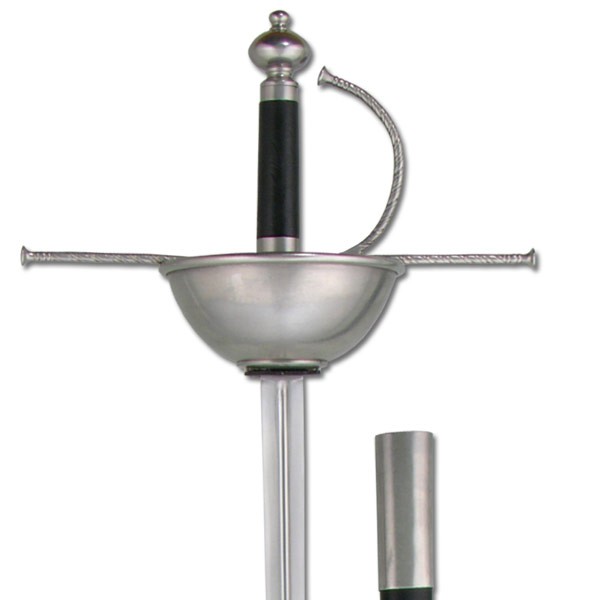 The rapier, that distinguished weapon that blends with civilian attire, is the emblem of the Spanish Golden Age. It was not just a tool for defense but a symbol of status and honor for gentlemen. Its splendor spans from the 15th to the late 17th century, marking an era of duels and self-defense.
The rapier, that distinguished weapon that blends with civilian attire, is the emblem of the Spanish Golden Age. It was not just a tool for defense but a symbol of status and honor for gentlemen. Its splendor spans from the 15th to the late 17th century, marking an era of duels and self-defense.
Distinctive Features of the Rapier:
- Blade: Long, straight, and slender, meticulously designed for thrusting, reaching 90 to 130 cm.
- Weight: Light and manageable, around one kilogram, allowing for agile and precise movements.
Most Coveted Guards by Collectors:
- Loop Guard: The oldest, with intertwined quillons and metallic branches, popular between 1550 and 1620.
- Shell Guard: A typically Spanish guard, offering greater protection with its iron plates, in use from 1640 to 1790. It is a testament to Iberian adaptation and functionality.
- Cup Guard (Cazoleta): The definitive evolution, with a hemispherical shell for maximum hand protection, used between 1628 and 1731, both in Spain and Italy.
2. The Tizona and the Colada: Echoes of El Cid Campeador
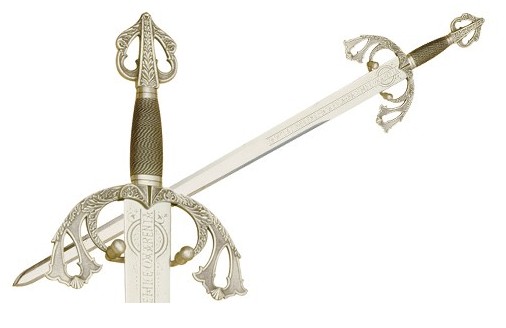
Few swords resonate in the collective Spanish memory with the force of the Tizona and the Colada, legendary companions of Rodrigo Díaz de Vivar, El Cid Campeador. These are not just swords; they are relics that encapsulate the spirit of the Reconquista and the figure of one of the greatest heroes in Spanish history. Their value lies in their immense historical and cultural significance.
- The Tizona: Famous for its supernatural virtues and its inscription that stated “Io soi Tisona fue fecha en la er de mile quarenta”, it was a robust battle sword with a black iron hilt, instilling fear in adversaries and granting almost mystical invincibility to its wielder.
-

Colada Sword of El Cid The Colada: Similar to the Tizona, but distinguished by its loop guard, specifically designed to protect the knight’s hand in the heat of battle.
Both swords continue to enchant collectors due to their undeniable connection to legend and the importance Isabella the Catholic herself gave them, including them in her personal inventory.
3. The Falcata: The Iberian Blade that Conquered Rome
 The falcata is a masterpiece of Iberian metallurgy with over two millennia of history, forged by peninsular artisans in the 5th century BC. Its unique design and effectiveness propelled it to fame, making it a symbol of the resistance and ingenuity of pre-Roman peoples.
The falcata is a masterpiece of Iberian metallurgy with over two millennia of history, forged by peninsular artisans in the 5th century BC. Its unique design and effectiveness propelled it to fame, making it a symbol of the resistance and ingenuity of pre-Roman peoples.
- Curved Blade: Its distinctive curved shape maximized cutting and thrusting power, making it feared on the battlefield.
- Central Ridge: This feature gave it exceptional strength and penetration capability that surpassed any defense of the era.
Such was its reputation that Hannibal chose it for his army, and the Romans themselves, recognizing its superiority, adopted it under the name of Gladius Ibericus. Today, the falcata is an essential piece in any collection aspiring to tell the story of Spanish swords, valued for its unique design and historical impact.
4. The Montante: The Brute Force of the Spanish Infantry
When battle turned to hand-to-hand combat, and the knight lost his mount, the montante emerged as the forceful answer. This imposing two-handed sword was the queen of the infantry, the formidable shock weapon of mercenaries and heroes alike.
- Usage: Perfect for breaking through enemy formations and for decisive foot combat.
- Symbol of Power: The montante transcended its warlike function to become the ultimate symbol of authority and strength, worthy of the bravest captains.
Spanish heroes of the stature of Don Diego García de Paredes, “The Samson of Extremadura,” and Don Alonso de Céspedes, “The Alcides Castellano,” forged their legend with the montante. Its size, its history linked to legendary feats, and its representation of military might make it a piece of extremely high value for collectors.
5. Pontifical Rapiers: Symbols of Faith and Power
Pontifical Rapiers were not just sabers; they were celestial distinctions, an honor granted by the Pope to those kings, princes, and captains who had demonstrated an unwavering commitment to the defense of the Faith. Blessed at Midnight Mass, these swords and their corresponding head coverings were gifts of incalculable symbolic value.
- Relevance in Spain: Spain, a bulwark of Christianity for centuries, received up to twenty-two of these rapiers.
- Illustrious Recipients: Among the fortunate recipients were figures such as John II, Henry IV, Ferdinand the Catholic, Emperor Charles, and Philip II, all bearers of a legacy of faith and power.
These swords, due to their direct connection with the highest ecclesiastical authority and their role in the religious and political history of Spain, are pieces of immense interest to collectors seeking objects with a deep symbolic charge and documented historical lineage.
Do you want to buy replicas of Spanish Swords?
Why Do Expert Collectors Seek These Pieces?
The value of historical Spanish swords transcends their mere antiquity. Their appeal to expert collectors is based on several unshakeable pillars that make them true gems:
- History and Legacy: Each sword is an echo of its time, connected to historical figures, epic battles, and moments that shaped the course of Spain and the world. To own one of these pieces is to possess a tangible fragment of history.
- Craftsmanship and Culture: The mastery with which they were forged, the beauty of their hilts, and the complexity of their guards are not just details; they are expressions of unique art and culture. The craftsmanship of Spanish swords, from the falcata to the rapier, reflects centuries of innovation and skill.
- Demand and Market Value: The scarcity and constant demand for these historical pieces drive their value in the collecting market. Although original pieces are difficult to find, the high interest is reflected in the popularity and value of faithful replicas, which allow enthusiasts to own a piece of that grand history.
In the world of collecting, the value of these swords is not measured solely in metal or stone, but in the stories they can tell and the legacy they represent. They are much more than objects; they are custodians of a glorious past, inviting their owners to connect with the legends of an empire that left its mark on steel.
VIEW SPANISH SWORDS | Alfonso X Swords | Charlemagne Swords | Charles III Swords | Charles V Swords | Colada Swords | Duke of Alba Swords | Philip II Swords | Great Captain Swords | Catholic Monarchs Swords | Tizona Swords | Bullfighter Swords

